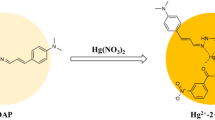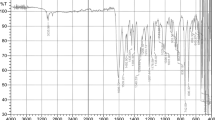Abstract
In this study, a simple Schiff base sensor 1-(((4-nitrophenyl)imino)methyl)naphthalen-2-ol(NNM) has been used for chemosensing of metal ions. The metal sensing properties of sensor NNM have been investigated using UV-visible and fluorescence spectroscopic approaches. The spectral investigations revealed a red shift in absorption spectra and quenching in the emission band of the ligand molecule in the presence of Cu2+ and Ni2+ ions. The binding stoichiometry of sensor NNM for the analyte (Cu2+ and Ni2+ ions) has been investigated by the Job’s plot analysis and found to be 1:1 (NNM:Analyte). The data of the Benesi-Hildebrand plot demonstrated that NNM detected Cu2+ and Ni2+ ions in nanomolar quantity. The binding insights among NNM and analytes (Cu2+ and Ni2+ ions) have been confirmed by shifted IR signals. Moreover, the reusabilty of the sensor has been investigated using an EDTA solution. In addition, the sensor NNM also successfully applied to real water samples for the identification and measurement of Cu2+ and Ni2+ ions. Hence, this system could be highly applicable in environmental and biological applications.









Similar content being viewed by others
Availability of Data and Materials
Data and materials are available on demand.
References
Yin P, Ma W, Liu J, Hu T, Wei T, Chen J, Li T, Niu Q (2022) Dual functional chemosensor for nano-level detection of Al3+ and Cu2+: Application to real samples analysis, colorimetric test strips and molecular logic gates. Microchem J 180:107557
Na YJ, Choi YW, You GR, Kim C (2016) A novel selective colorimetric chemosensor for cobalt ions in a near perfect aqueous solution. Sens Actuators B Chem 223:234–240
Zheng X, Cheng W, Ji C, Zhang J, Yin M (2020) Detection of metal ions in biological systems: A review. Rev Anal Chem 39:231–246
Gong T, Liu J, Liu X, Liu J, Xiang J, Wu Y (2016) A sensitive and selective sensing platform based on CdTe QDs in the presence of L-cysteine for detection of silver, mercury and copper ions in water and various drinks. Food Chem 213:306–312
Virender, Mohan B, Kumar S, Modi K, Deshmukh A H, Kumar A (2021) 2-((E)-1-((E)-(2-methoxybenzylidene) hydrazono) ethyl) phenol based cost-effective sensor for the selective detection of Eu3+ ions. Polyhedron 209
Barakat M (2011) New trends in removing heavy metals from industrial wastewater. Arab J Chem 4:361–377
Wu D, Chen L, Lee W, Ko G, Yin J, Yoon J (2018) Recent progress in the development of organic dye based near-infrared fluorescence probes for metal ions. Coord Chem Rev 354:74–97
Briffa J, Sinagra E, Blundell R (2020) Heavy metal pollution in the environment and their toxicological effects on humans. Heliyon 6:e04691
Berhanu AL, Mohiuddin I, Malik AK, Aulakh JS, Kumar V, Kim K-H (2019) A review of the applications of Schiff bases as optical chemical sensors. TrAC Trends Anal Chem 116:74–91
Feng S, Gao Q, Gao X, Yin J, Jiao Y (2019) Fluorescent sensor for copper (II) ions based on coumarin derivative and its application in cell imaging. Inorg Chem Commun 102:51–56
Reeves PG, DeMars LC (2004) Copper deficiency reduces iron absorption and biological half-life in male rats. J Nutr 134:1953–1957
Gaggelli E, Kozlowski H, Valensin D, Valensin G (2006) Copper homeostasis and neurodegenerative disorders (Alzheimer's, prion, and Parkinson's diseases and amyotrophic lateral sclerosis). Chem Rev 106:1995–2044
Anastassopoulou J, Theophanides T (1995) The Role of Metal Ions in Biological Systems and Medicine. In: Kessissoglou DP (ed) Bioinorganic Chemistry: An Inorganic Perspective of Life. Springer, Netherlands, Dordrecht, pp 209–218
Yang X, Zhang W, Yi Z, Xu H, Wei J, Hao L (2017) Highly sensitive and selective fluorescent sensor for copper (II) based on salicylaldehyde Schiff-base derivatives with aggregation induced emission and mechanoluminescence. New J Chem 41:11079–11088
S.W. Ragsdale, Nickel and Its Surprising Impact in Nature. Metal Ions in Life Sciences, Vol. 2. Edited by Astrid Sigel, Helmut Sigel, and Roland KO Sigel, in, Wiley Online Library, 2008.
Kaur K, Saini R, Kumar A, Luxami V, Kaur N, Singh P, Kumar S (2012) Chemodosimeters: an approach for detection and estimation of biologically and medically relevant metal ions, anions and thiols. Coord Chem Rev 256:1992–2028
Boer JL, Mulrooney SB, Hausinger RP (2014) Nickel-dependent metalloenzymes. Arch Biochem Biophys 544:142–152
Kumar A, Virender, Saini M, Mohan B, Kamboj M (2022) Colorimetric and fluorescent Schiff base sensors for trace detection of pollutants and biologically significant cations: A review (2010-2021). Microchem J 181
M. Moustakas, The role of metal ions in biology, biochemistry and medicine, in, Multidisciplinary Digital Publishing Institute, 2021, pp. 549.
Chowdhury B, Karar M, Paul S, Joshi M, Choudhury AR, Biswas B (2018) Salen type ligand as a selective and sensitive nickel (II) ion chemosensor: a combined investigation with experimental and theoretical modelling. Sens Actuators B Chem 276:560–566
Kumar A, Virender, Mohan B, Parikh J, Modi K (2023) The spectroscopic and computational study of anthracene based chemosensor-Ag+ interactions. Spectrochim. Acta A Mol Biomol Spectrosc 285
Kuntz I Jr, Gasparro F, Johnston M Jr, Taylor R (1968) Molecular interactions and the Benesi-Hildebrand equation. J Am Chem Soc 90:4778–4781
Zorn ME, Gibbons RD, Sonzogni WC (1999) Evaluation of approximate methods for calculating the limit of detection and limit of quantification. Environ Sci Technol 33:2291–2295
Jia W-G, Wang Z-B, Zhi X-T, Han J-Q, Sun Y (2017) Syntheses, characterization and catalytic activities of half-sandwich ruthenium complexes with naphthalene-based Schiff base ligands. J Coord Chem 70:848–858
Fu Y, Feng Q-C, Jiang X-J, Xu H, Li M, Zang S-Q (2014) New fluorescent sensor for Cu2+ and S2− in 100% aqueous solution based on displacement approach. Dalton Trans 43:5815–5822
Singh TS, Paul PC, Pramanik HA (2014) Fluorescent chemosensor based on sensitive Schiff base for selective detection of Zn2+. Spectrochim Acta Part A Mol Biomol Spectrosc 121:520–526
Wang Y, Wu H, Wu W-N, Li S-J, Xu Z-H, Xu Z-Q, Fan Y-C, Zhao X-L, Liu B-Z (2018) An AIRE active Schiff base bearing coumarin and pyrrole unit: Cu2+ detection in either solution or aggregation states. Sens Actuators B Chem 260:106–115
Singh G, Singh A, Satija P, Singh J, Singh J (2021) Schiff base-functionalized silatrane-based receptor as a potential chemo-sensor for the detection of Al3+ ions. New J Chem 45:7850–7859
Gupta VK, Singh AK, Kumawat LK (2014) Thiazole Schiff base turn-on fluorescent chemosensor for Al3+ ion. Sens Actuators B Chem 195:98–108
Kumar A, Mohan B, Solovev AA, Saini M, Sharma HK (2022) Development of 2-hydroxy-naphthaldehyde functionalized Schiff base chemosensor for spectroscopic and colorimetric detection of Cu2+ and Pd2+ ions. Microchem J 180
Formica M, Fusi V, Giorgi L, Micheloni M (2012) New fluorescent chemosensors for metal ions in solution. Coord Chem Rev 256:170–192
Yuvaraj P, Ajantha J, Karuppusamy M, Easwaramoorthi S, Rao JR (2021) Hydrogen bond-assisted colorimetric picomolar level detection of Hg2+ ions in 100% aqueous solution. ACS Sustain Chem Eng 9:10309–10317
Ghorai A, Mondal J, Saha R, Bhattacharya S, Patra GK (2016) A highly sensitive reversible fluorescent-colorimetric azino bis-Schiff base sensor for rapid detection of Pb2+ in aqueous media. Anal Methods 8:2032–2040
Deepa A, Srinivasadesikan V, Lee S-L, Padmini V (2020) Highly selective and sensitive detection of histidine by naked eye and fluorimetric method in aqueous medium via hydrogen bonding. J Photochem Photobiol, A 400:112615
Yao D, Huang X, Guo F, Xie P (2018) A new fluorescent enhancement chemosensor for Al3+ and Fe3+ based on naphthyridine and benzothiazole groups. Sens Actuators B Chem 256:276–281
Mukherjee S, Hazra S, Chowdhury S, Sarkar S, Chattopadhyay K, Pramanik A (2018) A novel pyrrole fused coumarin based highly sensitive and selective fluorescence chemosensor for detection of Cu2+ ions and applications towards live cell imaging. J Photochem Photobiol A 364:635–644
Li M, Ruan S, Yang H, Zhang Y, Yang Y, Song J, Xu X, Wang Z, Wang S (2020) Nopinone-based AIE-active dual-functional fluorescent chemosensor for Hg2+ and Cu2+ and its environmental and biological applications. Dalton Trans 49:15299–15309
Kumar A, Mohan B, Modi K, Din MAU, Kumar S (2022) A highly selective ratiometric and colorimetric detection of Ni2+ and Cu2+ ions using Schiff base ligand. J Mol Struct 1268:133609
Yang M, Zhang Y, Zhu W, Wang H, Huang J, Cheng L, Zhou H, Wu J, Tian Y (2015) Difunctional chemosensor for Cu(II) and Zn(II) based on Schiff base modified anthryl derivative with aggregation-induced emission enhancement and piezochromic characteristics. J Mater Chem C 3:1994–2002
Chen Y, Wang K (2013) Azacrown [N, S, O]-modified porphyrin sensor for detection of Ag+, Pb2+, and Cu2+. Photochem Photobiol Sci 12:2001–2007
Yang X, Zeng W, Wang L, Lu X, Yan Y, Qu J, Liu R (2014) A new fluorescent probe based on styrylcyanine dye containing pyridine: dissimilar fluorescent response to Cu2+ and Pb2+. RSC Adv 4:22613–22616
Sahu M, Manna AK, Chowdhury S, Patra GK (2020) A novel dihydro phenylquinazolinone-based two-in-one colourimetric chemosensor for nickel (ii), copper (ii) and its copper complex for the fluorescent colourimetric nanomolar detection of the cyanide anion. RSC Adv 10:44860–44875
Rani R, Paul K, Luxami V (2016) An NBD-based two-in-one Cu2+/Ni2+ chemosensor with differential charge transfer processes. New J Chem 40:2418–2422
Manna AK, Rout K, Chowdhury S, Patra GK (2019) A dual-mode highly selective and sensitive Schiff base chemosensor for fluorescent colorimetric detection of Ni2+ and colorimetric detection of Cu2+. Photochem Photobiol Sci 18:1512–1525
Tomer N, Goel A, Ghule VD, Malhotra R (2021) A chromone based Schiff base: An efficient colorimetric sensor for specific detection of Cu (II) ion in real water samples. J Mol Struct 1227:129549
Acknowledgments
The authors are thankful to the Department of chemistry, Baba Mastnath University, Asthal Bohar, Rohtak and the Department of chemistry, Kurukshetra University, Kurukshetra (India), for providing spectral facilities, including NMR spectroscopy.
Author information
Authors and Affiliations
Contributions
Original draft preparation, writing, methodology by Jasbir Singh and Pallavi Bhardwaj. Formal analysis, review and editing by Ravish K. Chauhan. Formal analysis, data interpretation by Brij Mohan and Ashwani Kumar.
Corresponding authors
Ethics declarations
Ethical Approval
No such data applies to human and/ or animal studies. This work is novel and not been published till in any journal or thesis work.
Conflicts of Competing Interest
The authors declare that they have no known competing financial interests or personal relationships that could have appeared to influence the work reported in this paper.
Additional information
Publisher's Note
Springer Nature remains neutral with regard to jurisdictional claims in published maps and institutional affiliations.
Supplementary Information
Below is the link to the electronic supplementary material.
Rights and permissions
Springer Nature or its licensor (e.g. a society or other partner) holds exclusive rights to this article under a publishing agreement with the author(s) or other rightsholder(s); author self-archiving of the accepted manuscript version of this article is solely governed by the terms of such publishing agreement and applicable law.
About this article
Cite this article
Singh, J., Mohan, B., Kumar, A. et al. Naphthaldehyde-Based Schiff Base Chemosensor for the Dual Sensing of Cu2+ and Ni2+ Ions. J Fluoresc 34, 149–157 (2024). https://doi.org/10.1007/s10895-023-03245-9
Received:
Accepted:
Published:
Issue Date:
DOI: https://doi.org/10.1007/s10895-023-03245-9




